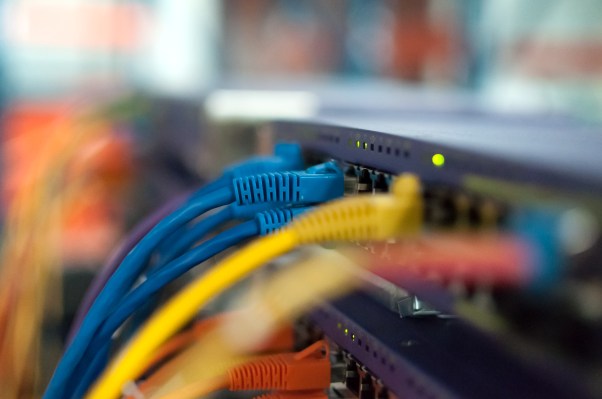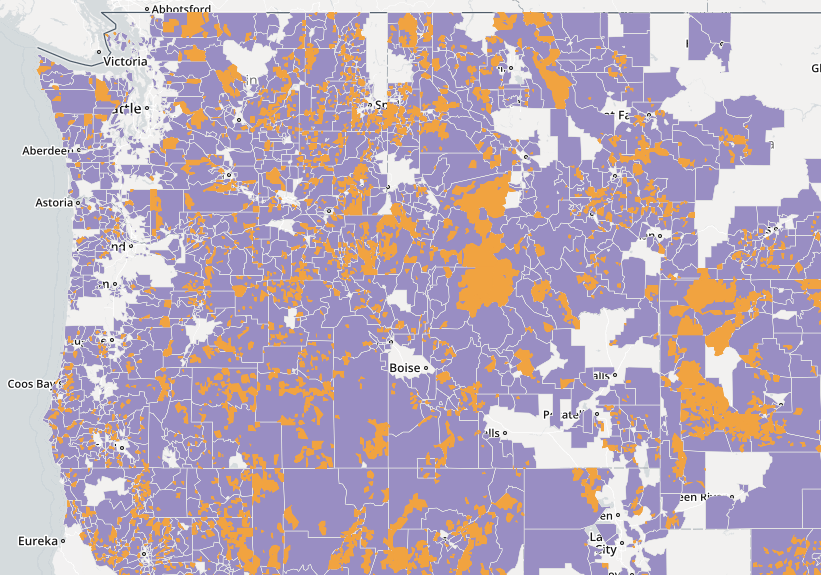The FCC has taken the final steps toward finally opening its long-delayed Connect America Fund II, which will disburse $2 billion in federal money over 10 years to support new broadband infrastructure in rural areas throughout the country. A date for bidding and the final documentation of the process were finally released today — though a bit of official infighting acted as a reminder that not all is well at the agency.
CAF II works like many other government reverse auctions — the agency or whoever publicize the tasks and locations it will subsidize work in, and companies submit bids to fulfill them. In this case the task is deploying broadband and the location is thousands of census units outside of the generally well-served urban areas. You can view a full map here, but the excerpt below is representative:
The purple parts are census “groups” that would be bid on while the orange parts are census blocks that would need to be served. That means you can’t just serve one or two of the most lucrative ones.
Accelerating CAF II is one of the FCC’s legitimate claims to progress over the last year, which it rightfully gave pole position in Chairman Pai’s highly selective summary of the agency’s 2017 accomplishments. The fund was proposed back in 2013, but for various reasons never saw the light of day. Pai made it an official priority of his upon taking the Chairman office, and to his credit he and the others have made good on his promise to get it out the door in 2018.
“With our decisions today, we jump the last big hurdle before holding a first-of-its-kind universal service reverse auction,” said Chairman Pai in an accompanying statement. “And I’ll remind
everyone that CAF II is only the beginning. In 2019, we will move on to the Remote Areas Fund for
those areas still without high-speed broadband. Rural America has waited long enough.”
The Connect America Fund auction will take place in July, but if you’re a broadband provider (or aspire to be one) you’ll need to indicate your intention to participate by the end of March, presumably so there’s plenty of time for vetting and getting all the necessary paperwork settled.
The decision to go ahead was met with nearly unanimous agreement by the various Commissioners, who all filed their own statements.
“This effort has been many years in the making. It’s exciting—because with these decisions we are taking steps into the future of high-cost universal service,” wrote Commissioner Rosenworcel, who has had some choice words for other agency decisions recently. “We are experimenting with new opportunities for providers to build broadband in some of our most rural communities that have been among our most challenging places to serve. This forward-thinking effort has my support.”
With hundreds of millions yearly planned to go out the door to local broadband deployment firms and their friends in infrastructure, we could see some real improvements to connectivity off the beaten paths, though it will take time.
Back to business as usual
It’s good that the FCC still functions well for this kind of important work, but a significant detail led to a bit of inter-office conflict that reminds us that this is still a sharply divided office.
Commissioner Clyburn noted in her accompanying statement that “despite our unified desire as a Commission to spur deployment on Tribal lands, we do not take any action here,” although Tribal lands in rural areas are disproportionately less connected.
“What’s the hold up?” she asked in a separate statement. “Chairman Pai repeatedly claims that closing the digital divide is among his top priorities, yet nearly a year has elapsed since a proposal was first put forward to help improve connectivity for Native communities and still no action.”
Pai responded, saying that an order to increase federal funding for development in Tribal areas had been presented last February:
So what was the hold up? Despite having formally voted for the item, Commissioner Clyburn’s office had privately and repeatedly threatened to withdraw her critical third vote in favor of the order if we moved to bring this item across the finish line. It is worth noting that her threat had nothing to do with what is actually contained in the order. Then, this morning, she carried through on that threat and withdrew her critical third vote in favor of the order.
If Commissioner Clyburn believes as I do that the Commission should take action to expand broadband access on Tribal lands, the way forward is simple. Instead of quietly changing her vote on a Friday morning and issuing a Friday afternoon press release designed to shift the blame, she should cast her vote in favor of an order that will increase federal funding for broadband infrastructure on Tribal lands. It’s that simple.
Not one to let Pai have the last word, Clyburn shot back:
Maybe I missed it. I thought my role as Acting Chair of the Federal Communications Commission (FCC) ended in November 2013? But if the authority implied by Chairman Pai’s statement is one I possess, then the Tribal broadband item would be adopted by close of business today.
Correction: I did not withdraw my vote. My vote on the initial item was cast seven months ago and in case you missed it, I’m currently in the minority. I’m the holdup? How is voting to approve the entire text of the item but dissenting in part, as I did today, because it did not go far enough to support our tribal communities, delaying the vote?
I await Chairman Pai’s retort.

